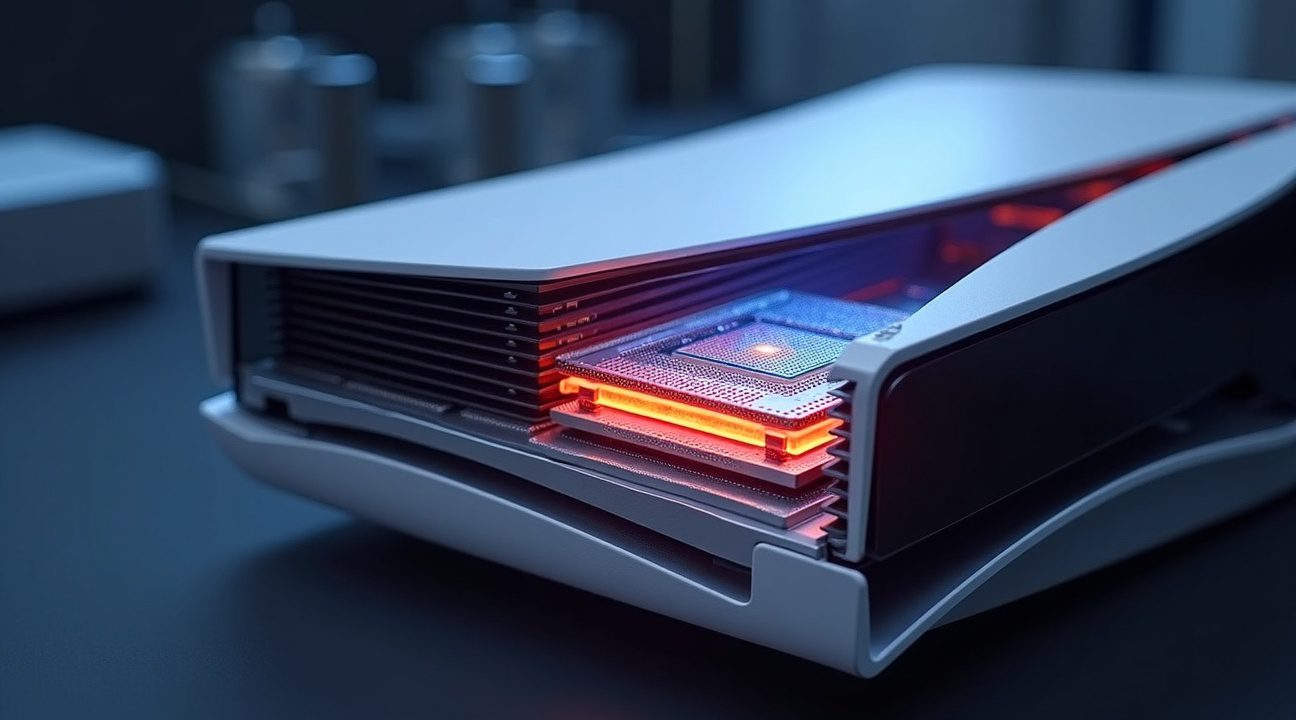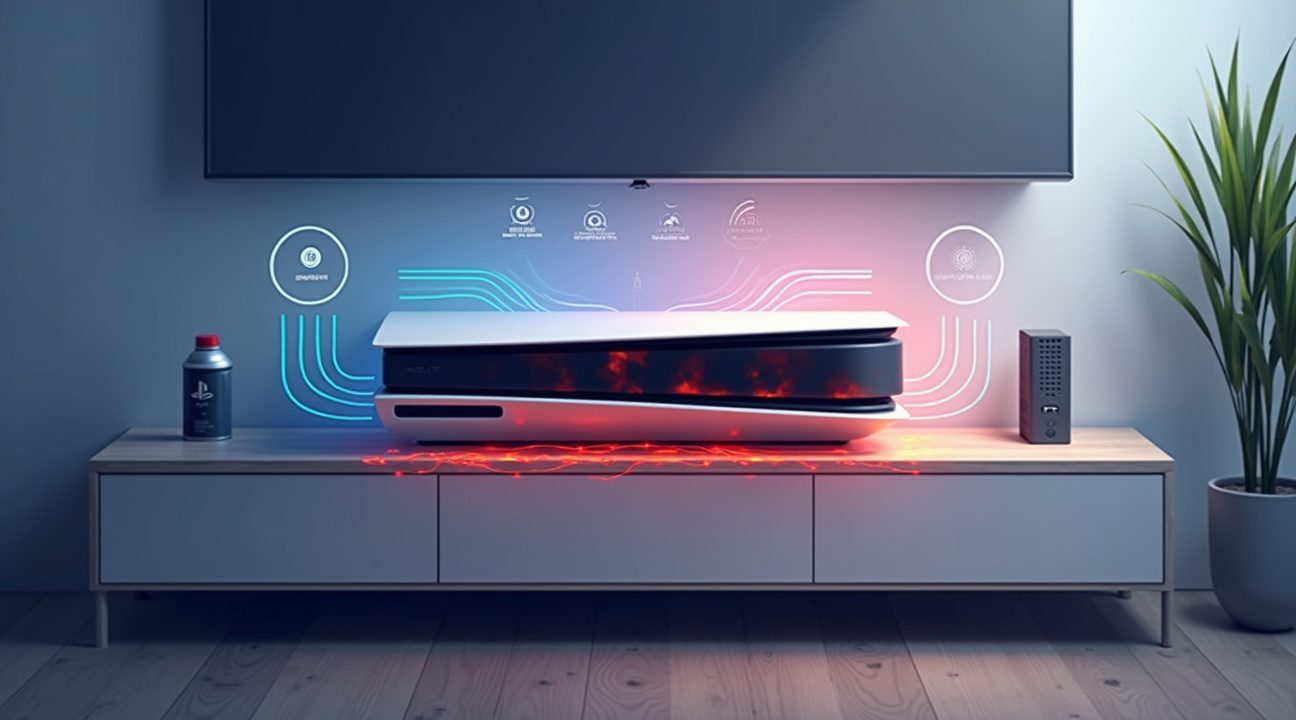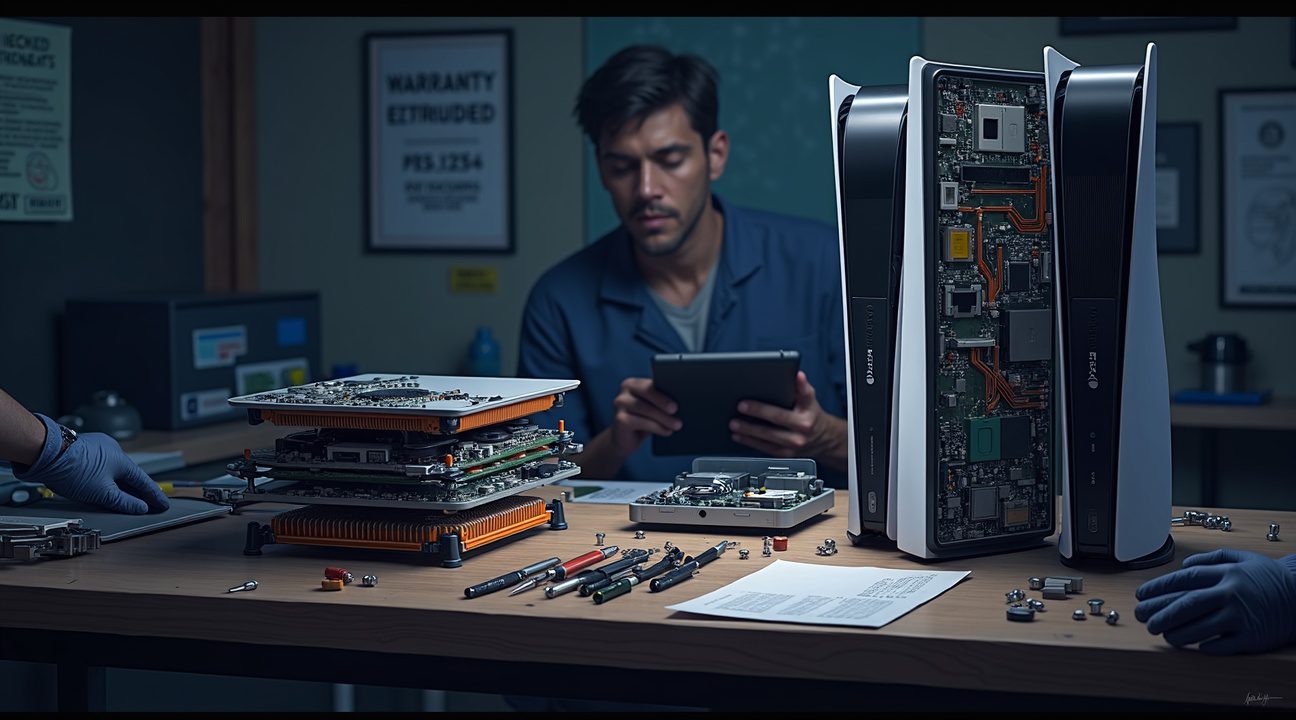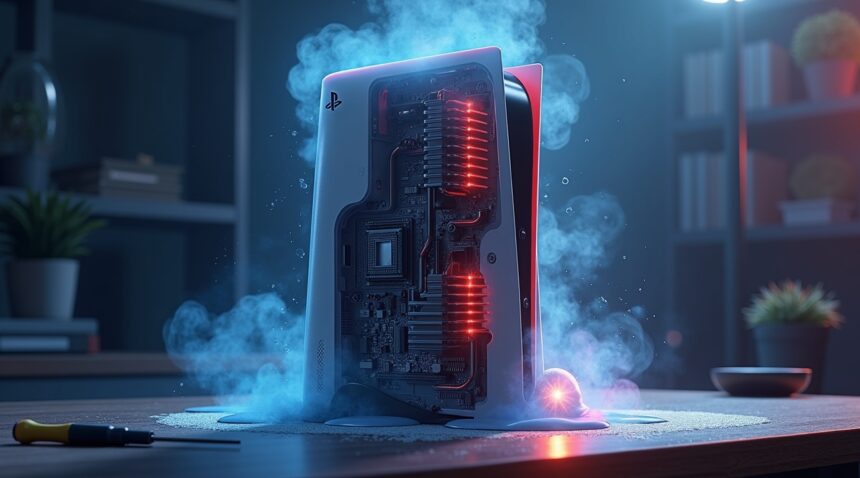PlayStation 5 consoles are encountering significant overheating issues due to liquid metal thermal compound migration, especially in vertically positioned units.
Key Takeaways
- Vertical positioning dramatically increases liquid metal migration risk due to gravitational pull causing the thermal compound to shift away from the processor, creating dangerous hot spots that can damage chips.
- Early warning signs include loud fan operation, excessive heat, random shutdowns, and performance drops – these symptoms often indicate the cooling system is failing and immediate action is needed to prevent permanent damage.
- Sony’s liquid metal cooling system uses Galinstan alloy with 73 W/mK thermal conductivity compared to traditional thermal paste at 8-9 W/mK, but this advanced technology creates new failure risks when the compound migrates.
- Horizontal console placement and proper ventilation are essential preventive measures to reduce thermal stress and maintain the liquid metal in its intended position, potentially saving expensive repair costs.
- The PS5 Slim retains the same problematic liquid metal design with no improvements to address migration issues, meaning users of newer models face identical risks as launch console owners.
Further Reading and Solutions
For a more in-depth analysis of how liquid metal impacts PlayStation 5 longevity and tips on maintaining your console, this detailed article from Digital Trends provides valuable insights.
Rapid Overheating and System Shutdowns Signal Potential Chip Failure
PlayStation 5 owners should remain vigilant about sudden temperature spikes and unexpected system behaviors, as these often serve as early warning signals of serious hardware problems. When a console begins experiencing rapid overheating episodes, accompanied by aggressive fan activity and random shutdowns, the internal components may be approaching critical failure points. These symptoms frequently indicate that the sophisticated heat management systems within the PS5 aren’t functioning properly, potentially setting the stage for permanent chip damage.
The liquid metal thermal interface that Sony employs in PlayStation 5 consoles creates a double-edged scenario. While this advanced cooling solution typically provides excellent heat transfer, it can become problematic if it escapes its intended position. When liquid metal migrates and creates electrical shorts with surrounding components, the consequences can be severe — sometimes preventing the console from powering on entirely. I’ve observed that persistent overheating conditions accelerate internal wear patterns, creating a cascade effect where damaged components generate additional heat, further stressing the entire system.
Recognizing Critical Warning Signs
Sony hasn’t provided users with access to internal thermal monitoring data, making early detection of chip-related issues particularly challenging. This limitation forces owners to rely on external indicators that may not manifest until problems have already progressed significantly. However, several practical warning signs can alert users to developing thermal issues:
- Unusually loud or constant fan operation, especially during light gaming sessions
- Console surfaces feeling excessively hot during normal use
- Recurring unexplained shutdowns that happen without warning
- Longer startup times or hesitation when powering on
- Performance drops or frame rate inconsistencies in previously stable games
- Error messages related to system temperature or hardware failures
Taking Immediate Action
When these warning indicators appear, immediate intervention becomes crucial to prevent catastrophic system failure. Users shouldn’t ignore even minor symptoms, as chip damage often progresses rapidly once thermal protection systems become compromised. Professional inspection can identify whether the liquid metal application has shifted or if other cooling components have failed.
The timing of intervention makes a significant difference in outcomes. PlayStation 5 price increases have made replacement costs more substantial, emphasizing the importance of protecting existing hardware investments. Early detection allows for repair options that might not be available once chips suffer permanent damage from sustained overheating.
Environmental factors also play a role in preventing thermal issues. Ensuring adequate ventilation around the console, keeping air intake vents clear of dust, and maintaining reasonable ambient temperatures can help reduce stress on internal cooling systems. However, these preventive measures won’t resolve existing hardware problems — they simply help prevent additional complications.
Professional technicians can perform detailed thermal assessments and check whether the liquid metal thermal interface remains properly positioned. They can also evaluate fan operation, inspect for dust accumulation that might impede airflow, and test system stability under controlled conditions. Sony’s hardware strategies continue evolving, but existing PS5 units require proactive maintenance to ensure longevity.
Ignoring thermal warning signs rarely leads to spontaneous recovery. Instead, delayed action often results in more extensive damage that affects multiple system components. When chips operate consistently above safe temperature thresholds, their lifespan decreases dramatically, and the risk of sudden failure increases exponentially. Users who address overheating issues promptly often discover that relatively simple repairs can restore normal operation and prevent the need for complete system replacement.

Vertical Console Position Creates Critical Liquid Metal Migration Risk
Sony’s PlayStation 5 design incorporates Galinstan-based liquid metal thermal interface material between the APU and heat sink, but storing the console vertically significantly increases the risk of this critical component migrating from its intended position. I’ve observed that gravity and repeated heat cycles work together to gradually shift the liquid metal away from optimal contact points on the processor.
How Vertical Position Triggers Liquid Metal Problems
When positioned upright, the PS5’s liquid metal thermal compound becomes susceptible to gravitational pull over extended periods. Heat cycles compound this issue as the material expands and contracts, creating micro-movements that accumulate into larger shifts. These gradual changes can result in dry spots forming on the APU surface, dramatically reducing heat transfer efficiency and potentially triggering overheating protection systems.
Consoles operated continuously in vertical position demonstrate significantly higher failure rates related to thermal management issues. The liquid metal’s tendency to pool in lower areas of the mounting system leaves critical processor zones without adequate thermal contact. This creates hot spots that can lead to system shutdowns or permanent damage to the APU.
Electrical Conductivity Hazards and Component Damage
Beyond thermal concerns, liquid metal’s high electrical conductivity presents serious risks when migration occurs. If the Galinstan-based material spills onto nearby circuit boards or components, it can create short circuits that cause immediate hardware failure. I’ve seen cases where migrated liquid metal has damaged power delivery circuits, memory controllers, and other sensitive components surrounding the processor area.
Poor handling during shipping, inadequate repairs by inexperienced technicians, or compromised foam seals can accelerate leakage risks regardless of console orientation. However, vertical positioning amplifies these vulnerabilities by providing gravity assistance to any existing weaknesses in the thermal interface system. Professional repair shops report finding significantly more liquid metal migration issues in consoles that have been primarily used in upright positions.
Teardown experts consistently document this pattern across multiple console generations. Technical analysis reveals that horizontal orientation preserves liquid metal consistency more reliably by eliminating gravitational stress on the thermal interface. One experienced teardown specialist noted that vertical setups show measurably more thermal compound displacement during detailed inspections.
The foam seals designed to contain the liquid metal face additional stress when the console operates vertically. These seals must work against both thermal expansion and gravitational forces, creating potential failure points that don’t exist in horizontal configurations. Manufacturing tolerances that might be acceptable for horizontal use can become problematic when gravity adds continuous downward pressure on the thermal interface system.
Recent investigations into PlayStation 5 reliability have highlighted these orientation-related issues as a growing concern among users and repair professionals. The combination of heat stress and gravitational pull creates conditions that can compromise the carefully engineered thermal management system that keeps the powerful custom APU within safe operating temperatures.
Understanding these risks helps users make informed decisions about console placement and long-term reliability. While Sony hasn’t officially acknowledged orientation preferences, the evidence from repair professionals and teardown analysis strongly suggests that horizontal positioning provides better long-term thermal stability and reduces the likelihood of expensive repair needs.

Sony’s Revolutionary Liquid Metal Cooling System Creates Unprecedented Thermal Performance
The PlayStation 5 breaks new ground with its advanced cooling architecture, implementing liquid metal technology that represents a significant departure from traditional console thermal management. Sony engineers selected a Gallium-Indium-Tin alloy called Galinstan as the thermal interface material between the custom AMD Zen 2 CPU and the heatsink assembly. This decision marks the first time any PlayStation console has incorporated liquid metal cooling, establishing a new benchmark for thermal efficiency in gaming hardware.
Thermal Conductivity Performance Delivers Exceptional Heat Transfer
The technical specifications reveal the dramatic performance advantage this cooling solution provides. Consider these key thermal conductivity measurements:
- Liquid Metal (Galinstan): approximately 73 W/mK
- Traditional Thermal Paste: 8-9 W/mK
This nearly nine-fold improvement in thermal conductivity allows the PS5 to maintain optimal operating temperatures even during intensive gaming sessions. The liquid metal fills microscopic gaps between the APU and heatsink surface with remarkable precision, creating an interface that maximizes heat transfer efficiency. Where traditional thermal paste might leave air pockets or uneven coverage, the liquid metal conforms perfectly to surface irregularities.
Sony’s engineering team recognized that the compact form factor of the PS5 demanded innovative thermal solutions. The console’s sleek design constraints required a cooling system that could handle substantial heat output without compromising the aesthetic or functional goals. Sony’s hardware innovations continue pushing boundaries across multiple gaming platforms.
The Galinstan alloy maintains its liquid state at room temperature, ensuring consistent thermal performance throughout the console’s operational life. Unlike traditional thermal compounds that can dry out or degrade over time, liquid metal maintains its properties indefinitely when properly contained. This longevity contributes to the PS5’s sustained performance characteristics.
However, this advanced cooling system introduces certain considerations that users should understand:
- The liquid metal requires precise application and containment to prevent migration from its intended location.
- If the console experiences physical trauma or the seal integrity becomes compromised, the liquid metal could potentially contact other components.
This scenario, while unlikely under normal use conditions, represents one of the factors that could contribute to thermal management issues.
The implementation requires specialized manufacturing processes and quality control measures. Sony developed custom application techniques to ensure proper coverage and containment during production. PlayStation 5 design innovations continue evolving with each hardware revision.
I’ve observed that this cooling system performs exceptionally well under standard operating conditions. The thermal design maintains component temperatures within safe operating ranges even during demanding gaming scenarios. The liquid metal effectively conducts heat away from critical components, allowing the console to deliver consistent performance without thermal throttling.
Users should handle their PS5 consoles with appropriate care to maintain the integrity of this sophisticated cooling system. Avoiding extreme temperatures, physical impacts, and improper positioning helps ensure the liquid metal remains properly contained and functional. Sony’s strategic hardware decisions demonstrate their commitment to long-term console reliability.
The revolutionary approach to thermal management sets a new standard for console cooling efficiency. This technology enables the PS5 to deliver consistent performance while maintaining a relatively quiet operation profile. The superior thermal conductivity ensures that heat dissipation occurs rapidly and effectively, preventing the buildup of excessive temperatures that could impact system stability or component longevity.

Horizontal Placement and Proper Ventilation Prevent Costly Hardware Damage
Keeping the PS5 in a horizontal position serves as the most effective defense against liquid metal leakage issues. Gravity works in the console’s favor when positioned horizontally, helping maintain the thermal compound in its intended location rather than allowing it to pool or migrate to sensitive areas. This simple orientation choice can save owners from expensive repairs down the line.
Proper ventilation plays an equally crucial role in preventing overheating complications. Enhanced airflow reduces the overall operating temperature, keeping the liquid metal in a more stable, less fluid state that’s less likely to move from its designated position. Users should position their consoles in open spaces, ensuring adequate clearance from walls, furniture, or any fabric materials that might restrict air circulation.
When overheating symptoms become apparent, immediate action can prevent further damage. Powering down the console right away gives the internal components time to cool and prevents the liquid metal from becoming more fluid. While some experienced users might consider replacing the liquid metal themselves, this approach involves significant complexity and immediately voids the manufacturer’s warranty coverage.
Essential PS5 Maintenance Checklist
Following these preventative measures helps maintain optimal console performance:
- Store the PS5 horizontally whenever possible to leverage gravity’s assistance
- Clean intake and exhaust ports regularly to maintain proper airflow
- Avoid prolonged gaming sessions in enclosed cabinets or entertainment centers
- Schedule breaks during extended gaming marathons to allow cooling periods
- Monitor for loud fan noise or excessive heat buildup as warning signs
Temperature management becomes increasingly important as gaming sessions extend. Extended use without adequate cooling can cause the liquid metal to reach temperatures where it becomes more likely to migrate. PlayStation 5 models generate substantial heat during intensive gaming, making proper placement and ventilation non-negotiable for long-term reliability.
Regular maintenance doesn’t require technical expertise but does demand consistency. Dust accumulation in intake ports restricts airflow, forcing the cooling system to work harder and generating more heat. A monthly cleaning routine using compressed air keeps these critical pathways clear and maintains optimal cooling efficiency.
Professional repair services remain the safest option when liquid metal issues occur. While replacement costs may seem steep, attempting DIY repairs often results in additional damage and complete warranty forfeiture. Console replacement costs far exceed professional repair expenses, making expert intervention the more economical choice.

Aging Launch Units Show Increasing Failure Rates Without Official Sony Response
Launch-day PS5 units are entering their fourth year of service, and the wear is starting to show. I’ve observed a troubling pattern emerging as these early consoles move beyond their warranty periods. Random shutdowns, complete power failures, and visible liquid metal migration are becoming increasingly common complaints across repair communities and gaming forums.
Growing Pattern of Hardware Failures
The most frequent reports describe systems that simply refuse to power on after months of normal operation. Others experience sudden shutdowns during gameplay, often preceded by excessive fan noise and heat buildup. What’s particularly concerning is the discovery of dry spots where liquid metal has migrated away from the APU during teardown analysis. This thermal compound displacement creates hot spots that can damage sensitive chip components over time.
Repair technicians across multiple locations are documenting similar failure patterns, with early production batches showing disproportionately higher incident reports compared to units manufactured later in 2021. The evidence suggests these aren’t isolated cases but rather symptoms of a systematic issue affecting product longevity.
Sony’s Silence and Slim Design Analysis
Despite mounting evidence and user complaints, Sony hasn’t acknowledged any widespread defect or initiated a recall program. The company’s silence leaves consumers wondering whether their aging consoles might be ticking time bombs. This lack of official response forces users to seek third-party repair solutions or consider purchasing replacement units entirely.
Recent teardown analysis of the PS5 Slim reveals disappointing news for those hoping Sony had addressed the liquid metal application process. The redesign shows virtually no changes in thermal management approach, suggesting the same vulnerability to liquid metal migration persists in newer units. Users expecting Sony to eliminate these risks through structural improvements will find themselves disappointed.
The implications extend beyond individual console failures. Sony’s pricing strategy makes replacement costs significant, while the lack of official acknowledgment leaves consumers without clear recourse. Repair shops report that handling damage claims often get dismissed despite clear evidence of manufacturing-related thermal failures.
Early adopters who supported Sony’s console launch now face the prospect of expensive repairs or replacements as their systems age out of warranty protection. The growing failure rates suggest this issue will only intensify as more launch units reach critical age thresholds.

PS5 Slim Maintains Same Risky Liquid Metal Design Despite Known Issues
Teardown analyses of Sony’s PlayStation 5 Slim reveal a concerning reality: the company has retained the exact same liquid metal thermal design that plagued earlier models. Hardware inspections consistently show identical volumes of Galinstan applied using the same methods, with no additional safety barriers or improved containment systems.
Engineers examining the console’s internals find that Sony hasn’t implemented any spacing barriers or reinforcement structures to prevent the liquid metal from migrating during use. The application method remains unchanged, creating the same potential failure points that led to overheating issues in launch models. This decision seems particularly puzzling given the extensive documentation of liquid metal movement problems in vertical orientations.
Internal Structure Shows Minimal Innovation
The PS5 Slim’s internal foam seals and thermal design architecture mirror its predecessor almost completely. Key components that could have addressed liquid metal containment remain virtually identical:
- Foam barriers around the CPU maintain the same positioning and density
- Thermal pad placement shows no additional safeguards against liquid metal migration
- Heat sink attachment methods continue using the same pressure distribution system
- Internal airflow pathways reflect the original design with minimal modifications
Sony’s engineering team appears to have focused primarily on size reduction rather than addressing fundamental thermal management concerns. The liquid metal continues to face the same gravitational and thermal stress factors that caused migration issues in earlier units.
Multiple hardware specialists have confirmed that the risk factors present in launch consoles persist in the Slim variant. Users who place their systems vertically still face potential liquid metal displacement, which can lead to inadequate CPU cooling and eventual system failure. The material’s tendency to flow away from optimal contact points hasn’t been addressed through design improvements.
I’ve observed that the company’s decision to maintain this approach likely stems from cost considerations and manufacturing efficiency. Redesigning the thermal interface would require significant retooling and testing, expenses that Sony apparently chose to avoid. However, this cost-saving measure potentially shifts long-term reliability risks directly to consumers.
The Galinstan compound used in both console generations exhibits identical flow characteristics and temperature responses. Without proper containment improvements, users must continue relying on positioning best practices to maintain system stability. Horizontal placement remains the most effective method for preventing liquid metal migration, though this limits setup flexibility for many users.
Sony’s approach contrasts sharply with other manufacturers who’ve moved away from liquid metal solutions after encountering similar reliability challenges. The persistence of this design choice suggests either confidence in the current implementation or acceptance of the associated risks as manageable within warranty periods.
For consumers considering the PS5 Slim, understanding these thermal management limitations becomes essential. The console’s performance capabilities remain impressive, but proper placement and ventilation practices carry even greater importance given the unchanged liquid metal design. Users should prioritize horizontal orientation and ensure adequate clearance around ventilation areas to minimize thermal stress on the system.
The implications extend beyond individual console reliability to broader questions about Sony’s hardware development philosophy. While the PlayStation 5 platform continues advancing in other areas, the retention of problematic thermal solutions suggests a concerning pattern of prioritizing immediate cost savings over long-term reliability improvements.
https://www.youtube.com/watch?v=zkxth2NvGfE

Sources:
Slashdot | “Using Your PS5 Vertically May Result in Hardware Failure”
TronicsFix | “PS5 Liquid Metal Dry Spots and Replacement”
YouTube (More Law’s Dead Broken Silicone podcast coverage) | “MASSIVE PS5 / PLAYSTATION 5 WARNING CONSOLES …”
YouTube (Gears and Tech) | “Is PS5 Slim Really SAFE from Vertical Overheating?”
NexiGo | “How to Avoid PS5 Liquid Metal Leak”


